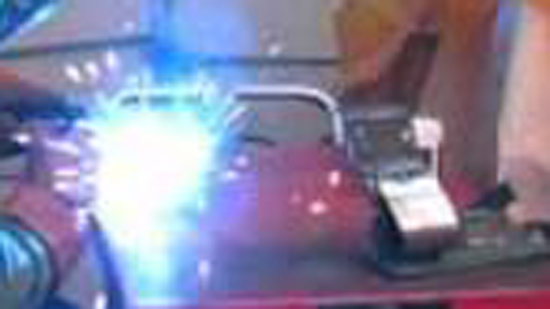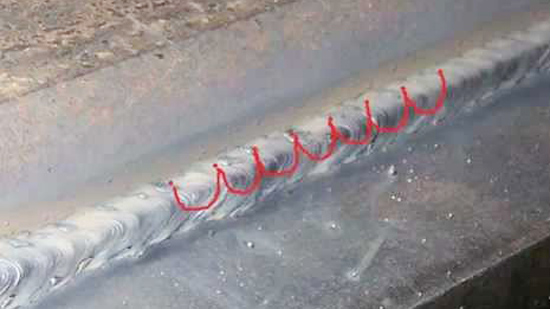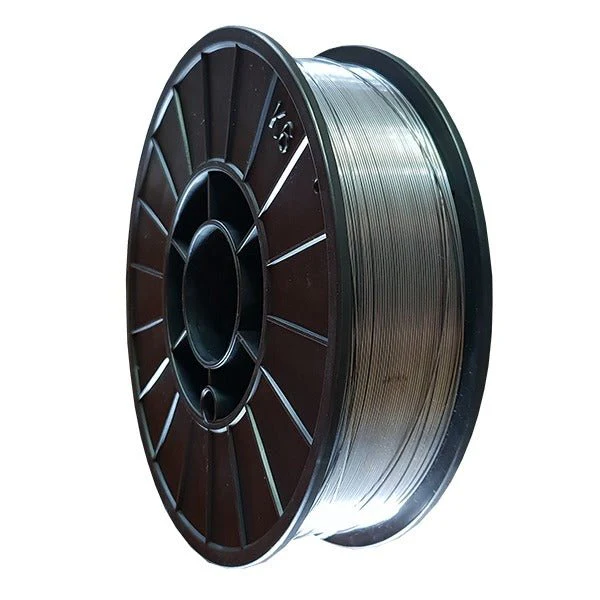MIG welding, also known as Gas Metal Arc Welding (GMAW), is a widely used welding process that utilizes a continuously fed wire electrode to join two metal pieces together. It is known for its versatility, ease of use, and ability to produce high-quality welds. One crucial aspect of MIG welding is the wire feed speed, which determines the rate at which the electrode wire is fed into the weld pool.
Understanding and calculating the wire feed speed accurately is essential for achieving optimal weld quality and efficiency. In this comprehensive guide, I will walk you through everything you need to know about calculating wire feed speed in MIG welding.

Image by newmetalworker
Importance of Wire Feed Speed in MIG Welding
The wire feed speed plays a crucial role in MIG welding as it directly affects the deposition rate of the filler metal. The deposition rate determines the amount of weld metal that is added to the joint per unit of time. If the wire feed speed is too slow, the weld bead will be narrow, resulting in poor penetration and weak welds.
On the other hand, if the wire feed speed is too high, the weld bead will be wider, leading to excessive heat input and potential distortion. Therefore, finding the right balance by accurately calculating the wire feed speed is essential for achieving robust and aesthetically pleasing welds.
Factors to Consider When Calculating Wire Feed Speed
Calculating the wire feed speed in MIG welding requires considering several factors to ensure accurate and optimal results. Here are the key factors you need to take into account:
Electrode Diameter
The diameter of the electrode wire determines the amount of current it can carry and the deposition rate. Thicker wires generally require higher wire feed speeds to achieve the desired weld size.
Welding Current
The welding current influences the melting rate of the electrode wire. Higher currents typically require faster wire feed speeds to maintain the desired deposition rate.
Base Metal Thickness
The thickness of the base metal affects the heat dissipation and required penetration. Thicker materials generally necessitate slower wire feed speeds to allow for proper fusion.
Welding Position
Different welding positions, such as flat, horizontal, vertical, and overhead, require adjustments in the wire feed speed to ensure proper weld bead shape and penetration.
By considering these factors and understanding their impact on the welding process, you can accurately calculate the wire feed speed for your specific welding application.
Step-by-Step Guide on How to Calculate Wire Feed Speed in MIG Welding
Now that we have a good understanding of the importance of wire feed speed and the factors involved let’s dive into the step-by-step process of calculating it accurately for MIG welding.
Gather the Required Information
Before you can calculate the wire feed speed, you need to gather some essential information, including the electrode diameter, welding current, base metal thickness, and welding position.
Determine the Deposition Rate
The deposition rate is the amount of weld metal deposited per unit of time. It can be calculated by multiplying the wire feed speed (in inches per minute) by the cross-sectional area of the electrode wire (? * (diameter/2)^2).
Calculate the Required Wire Feed Speed
To calculate the wire feed speed, divide the desired deposition rate by the cross-sectional area of the electrode wire. This will give you the wire feed speed required to achieve the desired weld size.
Adjust for Specific Welding Conditions
Depending on the welding conditions, such as welding position and base metal thickness, you may need to make adjustments to the calculated wire feed speed. Consult welding procedure specifications or guidelines to determine any necessary modifications.
Set the Wire Feed Speed
Input the calculated wire feed speed into the MIG welding machine or wire feeder and ensure it is set accurately before starting the welding process.
By following these steps and using the gathered information, you can calculate the wire feed speed accurately for your MIG welding applications, resulting in consistent and high-quality welds.
Common Challenges and Troubleshooting Techniques
While calculating and setting the wire feed speed correctly is crucial, there are some common challenges that you may encounter during the MIG welding process. Here are a few troubleshooting techniques to overcome these challenges:
Excessive Spatter
If you experience excessive spatter during welding, it could be a sign of a high wire feed speed. Decrease the wire feed speed slightly and check if the spatter reduces.
Lack of Penetration
Insufficient penetration may indicate a low wire feed speed. Increase the wire feed speed gradually and monitor the penetration until the desired level is achieved.
Inconsistent Weld Bead
Inconsistent weld bead appearance may be caused by inconsistent wire feed speed. Ensure a smooth and steady wire feed speed to achieve consistent weld bead formation.
Burn-Back
Burn-back occurs when the electrode wire fuses to the contact tip. It can be caused by excessive wire feed speed or improper contact tip usage. Adjust the wire feed speed and inspect the contact tip regularly to prevent burn-back.
By understanding these common challenges and employing the appropriate troubleshooting techniques, you can overcome them and ensure smooth and successful MIG welding operations.
Tips for Optimizing Wire Feed Speed for Different Materials and Applications
Optimizing the wire feed speed for different materials and applications is crucial to achieve the desired weld quality and efficiency. Here are some tips to help you optimize the wire feed speed:
Refer to Welding Procedure Specifications
Welding procedure specifications provided by material manufacturers or welding experts can offer valuable guidelines for selecting the appropriate wire feed speed for specific materials and applications.
Perform Test Welds
Conducting test welds using different wire feed speeds can help you identify the optimal settings for a particular material and application. Evaluate the weld quality, appearance, and penetration to determine the best wire feed speed.
Consider Material Thickness
Thicker materials generally require slower wire feed speeds to allow for proper heat input and fusion. Adjust the wire feed speed accordingly to achieve optimal results.
Monitor Weld Bead Appearance
Continuously monitor the appearance of the weld bead during welding. Adjust the wire feed speed if necessary to achieve the desired bead shape, size, and penetration.
By following these tips and adapting the wire feed speed to the specific materials and applications, you can optimize the MIG welding process and achieve superior weld quality.
Tools and Equipment for Accurate Wire Feed Speed Calculations
To ensure accurate wire feed speed calculations, you may require certain tools and equipment. Here are some essential tools and equipment:
Wire Feed Speed Meter
A wire feed speed meter is a device that measures the actual wire feed speed during welding. It provides real-time feedback, allowing you to adjust the settings as needed.
Digital Caliper
A digital caliper is used to measure the diameter of the electrode wire accurately. It ensures precise calculations of the cross-sectional area of the wire.
Welding Procedure Specifications
Welding procedure specifications provide valuable information on recommended wire feed speeds for various materials, base metal thicknesses, and welding positions. Refer to these specifications for accurate calculations.
Quality Welding Machine
A high-quality MIG welding machine or wire feeder with accurate wire feed speed controls is essential for precise calculations and consistent welding results.
By utilizing these tools and equipment, you can ensure accurate wire feed speed calculations and enhance the overall welding process.
Safety Precautions When Working with Wire Feed Speed in MIG Welding
Safety should always be a top priority when working with wire feed speed in MIG welding. Here are some crucial safety precautions to follow:
Wear Protective Gear
Always wear appropriate personal protective equipment, including welding gloves, safety glasses, welding helmet, and flame-resistant clothing, to protect yourself from potential hazards.
Ensure Proper Ventilation
MIG welding produces fumes and gases that can be harmful if inhaled. Ensure good ventilation in the welding area to prevent the accumulation of hazardous fumes.
Inspect Equipment Regularly
Regularly inspect the welding machine, wire feeder, and related equipment to ensure they are in good working condition. Faulty equipment can lead to unpredictable wire feed speed and potential accidents.
Handle Electrode Wire with Care
Handle the electrode wire with caution, as it can cause injuries if mishandled. Avoid contact with bare skin and use appropriate wire spools and guides to prevent tangling and wire entanglement.
By adhering to these safety precautions, you can create a safe working environment and minimize the risk of accidents during MIG welding.
Advanced Techniques and Strategies for Precise Wire Feed Speed Control
For experienced welders seeking more precise control over the wire feed speed, here are some advanced techniques and strategies to consider:
Pulse Welding
Pulse welding allows for precise control over the wire feed speed by alternating between high and low current pulses. It enables better control over heat input and weld pool dynamics.
Synergic Welding
Synergic welding is a feature available in some advanced MIG welding machines that automatically adjusts the wire feed speed based on the selected welding parameters. It simplifies the process and ensures consistent results.
Wire Feed Speed Monitoring
Continuously monitoring the wire feed speed using a wire feed speed meter can provide real-time feedback and enable on-the-fly adjustments to achieve optimal weld quality.
Automated Welding Systems
Automated welding systems, such as robotic welding cells, offer precise control over the wire feed speed and other welding parameters. These systems are ideal for high-volume production and complex welding applications.
By exploring these advanced techniques and strategies, you can elevate your wire feed speed control capabilities and achieve exceptional welding results.
Conclusion
Mastering the art of calculating and controlling wire feed speed in MIG welding is a crucial skill for welders looking to achieve high-quality welds consistently.
By understanding the importance of wire feed speed, considering the key factors involved, and following the step-by-step guide provided, you can accurately calculate the wire feed speed for your specific welding applications.
By troubleshooting common challenges, optimizing the wire feed speed for different materials and applications, and employing advanced techniques, you can further enhance your welding capabilities.

I’m Darrell Julian, the founder, lead writer, and hands-on welding enthusiast behind ArcWeldingPro.com. With more than 15 years of real-world welding experience, I created this platform to share what I’ve learned in the field, in the shop, and in the heat of the arc.



